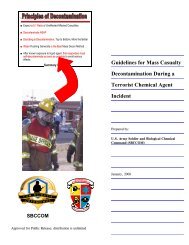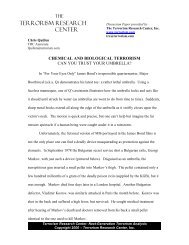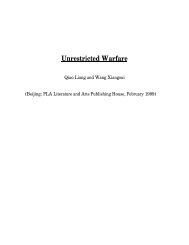Combating Proliferation of Weapons of Mass Destruction
Combating Proliferation of Weapons of Mass Destruction
Combating Proliferation of Weapons of Mass Destruction
You also want an ePaper? Increase the reach of your titles
YUMPU automatically turns print PDFs into web optimized ePapers that Google loves.
Department <strong>of</strong> EnergyThe Department <strong>of</strong> Energy (DOE) plays a key role in combating proliferation. Because <strong>of</strong>its expertise in nuclear weapons and nuclear power, DOE has greater knowledge than anyother agency in dealing with matters <strong>of</strong> nuclear proliferation. It manages the nationallaboratories, including the three national weapons laboratories, Los Alamos NationalLaboratory, Lawrence Livermore National Laboratory, and Sandia National Laboratoriesand the manufacturing complex for nuclear weapons. These have extraordinarytechnological capabilities that, if properly harnessed, can contribute enormously to allaspects <strong>of</strong> combating proliferation.The Commission’s review <strong>of</strong> DOE’s proliferation-related activities occurred during theperiod when major counterintelligence and security problems were made public. Since thattime, there have been several independent reviews and recommendations for significantchanges in the management <strong>of</strong> the weapons programs and <strong>of</strong> the national labs mostclosely associated with nuclear weapons. In general, the Commission is in sympathy withthe views <strong>of</strong> the recent report <strong>of</strong> the President’s Foreign Intelligence Advisory Board(PFIAB). Along those lines, the recommendations that the Commission makes seek t<strong>of</strong>ocus DOE more closely on nuclear proliferation-related activities in which the labs haveunique experience. The Commission endorses the PFIAB’s recommendation to place theOffice <strong>of</strong> Nonproliferation and National Security under a new Under Secretary <strong>of</strong> Energy,if such an <strong>of</strong>fice is created.DOE and its predecessor agencies, the Atomic Energy Commission (AEC) and the EnergyResearch & Development Administration (ERDA), have a long history in nuclearproliferation matters. In the 1950s and 1960s, the AEC was the principal agencyimplementing “Atoms for Peace,” a policy aimed at providing civilian nuclear technologyassistance to nations willing to forswear the acquisition <strong>of</strong> nuclear weapons. During thisperiod and until India’s nuclear explosion in 1974, the AEC, and later ERDA, alsosupported policies today considered proliferation risks, such as peaceful nuclearexplosions and export <strong>of</strong> commercial enrichment and reprocessing capabilities. Ever sinceits creation in 1977, DOE has been committed to advancing U.S. proliferation-relatedobjectives. Over time, several programs have emerged in DOE that bear on thoseobjectives. The most important relate to nuclear matters in the former Soviet Union. Theseinclude developing Materials Protection, Control, and Accounting (MPC&A) systems,disposition <strong>of</strong> weapons-usable fissile materials (notably the purchase <strong>of</strong> highly enricheduranium from Russia), participating in the Cooperative Threat Reduction effort, helping toconvert Russia’s three plutonium production reactors to fuel that will not produce weaponsgradeplutonium, and the Nuclear Cities Initiative.DOE’s strength is also its weakness. The Department and its laboratories are excellent atcreating new high-performance technology, although the cost to develop such technologyis high, and the laboratories do not have experience in procuring and deploying systems inthe commercial world. The expertise <strong>of</strong> the laboratory system is unparalleled in the nuclear62







